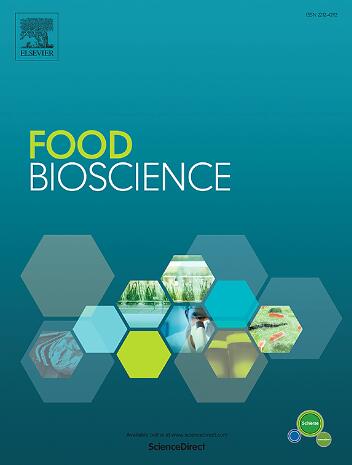Extraction of hydroxy safflower yellow A and anhydroxysafflor yellow B from safflower florets using natural deep eutectic solvents: Optimization, biological activity and molecular docking
IF 4.8
1区 农林科学
Q1 FOOD SCIENCE & TECHNOLOGY
引用次数: 0
Abstract
This study established an eco-friendly natural deep eutectic solvent (NADES) extraction system for simultaneous recovery of hydroxysafflor yellow A (HYSA) and anhydroxysafflor yellow B (AHSYB) from Safflower florets. Through systematic NADES screening, urea-sorbitol (Ur:Sor, 1:1) demonstrated superior extraction efficiency, yielding 20.98 ± 0.18 mg/g HYSA and 10.79 ± 0.22 mg/g AHSYB under optimized RSM conditions (75 % H2O, 30 min, 51 °C, 10 mL/g), representing 21 % and 34 % enhancements over conventional solvents. The urea-sorbitol extract has a strong free radical scavenging ability, with a 2,2-diphenyl-1-picrylhydrazyl (DPPH) scavenging rate of 92 % ± 2.6 %; its ferric reducing antioxidant power (FRAP) reducing capacity is 0.72 ± 0.07, and it also has xanthine oxidase (XO) inhibitory ability (half maximal inhibitory concentration (IC50) is 1.48 ± 0.06 mg/mL). Molecular docking studies showed that both HYSA and AHSYB effectively bind to the active site of XO. Molecular dynamics simulations indicated that these compounds are stable ligands, maintaining high stability during their binding dynamics with XO. The free binding energies of HYSA and AHSYB to XO were −54.72 and −50.51 kcal/mol, respectively. These results highlight the crucial role of NADES in improving the extraction yield and functional activity of bioactive compounds. The obtained compounds thus hold potential applications in the food industry.

用天然深共晶溶剂从红花小花中提取羟基红花黄A和无羟基红花黄B:优化、生物活性和分子对接
本研究建立了一种环保型天然深共溶溶剂(NADES)萃取体系,可同时从红花花中提取羟基红花黄A (HYSA)和无羟基红花黄B (AHSYB)。通过系统的NADES筛选,尿素-山梨醇(Ur:Sor, 1:1)在优化的RSM条件下(75% H2O, 30 min, 51°C, 10 mL/g)的提取率分别为20.98±0.18 mg/g HYSA和10.79±0.22 mg/g AHSYB,比传统溶剂分别提高21%和34%。尿素山梨醇提取物具有较强的自由基清除能力,对2,2-二苯基-1-苦味酰肼(DPPH)的清除率为92%±2.6%;其铁还原抗氧化能力(FRAP)为0.72±0.07,还具有抑制黄嘌呤氧化酶(XO)的能力(半数最大抑制浓度(IC50)为1.48±0.06 mg/mL)。分子对接研究表明,HYSA和AHSYB都能有效结合到XO的活性位点。分子动力学模拟表明,这些化合物是稳定的配体,在与XO的结合动力学过程中保持较高的稳定性。HYSA和AHSYB对XO的自由结合能分别为- 54.72和- 50.51 kcal/mol。这些结果突出了NADES在提高生物活性化合物提取率和功能活性方面的重要作用。因此,所获得的化合物在食品工业中具有潜在的应用前景。
本文章由计算机程序翻译,如有差异,请以英文原文为准。
求助全文
约1分钟内获得全文
求助全文
来源期刊

Food Bioscience
Biochemistry, Genetics and Molecular Biology-Biochemistry
CiteScore
6.40
自引率
5.80%
发文量
671
审稿时长
27 days
期刊介绍:
Food Bioscience is a peer-reviewed journal that aims to provide a forum for recent developments in the field of bio-related food research. The journal focuses on both fundamental and applied research worldwide, with special attention to ethnic and cultural aspects of food bioresearch.
 求助内容:
求助内容: 应助结果提醒方式:
应助结果提醒方式:


